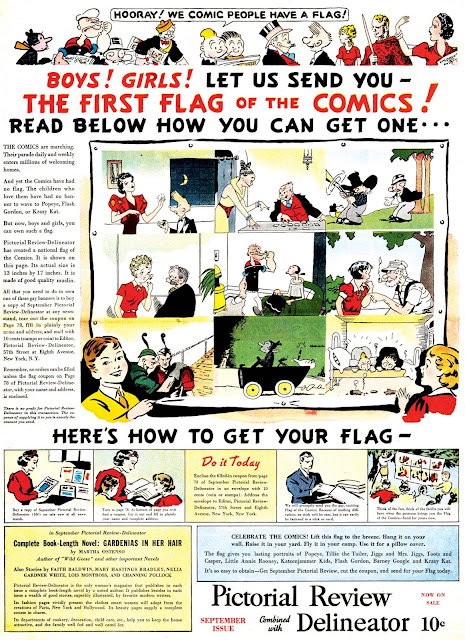In 1937 the Hearst Corporation purchased the phenomenally successful women’s magazine Pictorial Review, a magazine that had once boasted a circulation of 3 million per month. Granted, with the Depression the magazine didn’t sell quite that well in the 1930s, but it was still a force to be reckoned with when Hearst bought it. Bizarrely, Hearst discontinued the magazine in 1939, citing it as being in debt up to its ears. The story reeks of a tax evasion scam of some kind, and there were whisperings of some sort of mob connection to boot.
When Hearst purchased the ill-fated magazine one of the things they did was to create tie-in marketing with their newspapers. To market the Puck comic section, someone came up with the idea of a giveaway of ‘flags’ featuring some of the headliners from the comics line-up. I put flag in quotes because the actual item was just a flat sheet of muslin with no mounting hardware or eyelets. Kinda crummy even for ten cents in 1937. Arguably worse, though, is the design of the ‘flag’, which is nine comic panels seemingly taken almost completely at random from the strips, and just plopped down in a 3×3 grid. A flag with zero thought put into the design, in other words.
Not surprisingly, very few people sent in their dimes for this promotional dog and the flags are now exceedingly rare. Rare doesn’t mean valuable, though, since even today few collectors would really want to display the ugly thing. Hake’s couldn’t even get their minimum bid of a C-note for an example. To see a larger image of the flag you can visit WorthPoint, which claims a sale on eBay — but you have to be a member to find out what it went for. I suspect it was no king’s ransom.
Update: In a rather amazing coincidence, while this post was sitting in the queue what should appear on eBay but one of these flags! It went for the princely sum of 36 bucks, shipping included.


One actually gets a different story from looking at the litigation involved in the case Nahtel Corp. v. West Virginia Pulp & Paper, a 1943 case from the federal 2nd Circuit. The Pictorial Review lost $500,000 in 1929, and in 1930-1931 lost nearly $1.5 million. West Virginia Pulp & Paper was the supplier of paper to the magazine, and was concerned about the mounting debts the magazine owed the firm. There were some murky transactions described in the case regarding a corporate reorganization, to no avail. In between 1931 and 1934, when Hearst's interests bought the magazine, the court's opinion describes the magazine as getting into worse and worse financial condition, with the liabilities exceeding the assets by a fair margin. As a practical matter, judging from the court's opinion, the Pictorial Review was a dead duck. You can read the opinion online at: https://www.anylaw.com/case/nahtel-corp-v-west-virginia-pulp-paper-co/second-circuit/03-15-1943/GYCSPWYBTlTomsSBXR2q
Interesting. What I read and regurgitated above was definitely characterized as reporting on rumours, and I guess that's mostly what they were, not facts. –Allan
But then again, Hearst may well have purchased it as some sort of tax dodge. A company that far in debt might have had some sort of tax attraction. By the late 30s, though, he was drowning in a sea of red ink, and taxes were only one thing dragging him to the bottom. — Allan
It's hard to say: by all accounts, the various Hearst enterprises were in a massive tangle and muddle in the 1930s, though the effluvia hadn't hit the rotary object until later in the decade (see A.J. Liebling on the subject). The advent of the Securities Act of 1933 and the Securities Exchange Act of 1934 put a serious crimp on the ability of the organization to raise money, which is why you had some contractions later on in the 30s, when fresh suckers — I mean investors — couldn't be found. You'll note the reference to "The Delinieator" in what posted; that was another failing magazine that was bought and combined with The Pictorial Review which, though it served to boost circulation in the short term, didn't seem to work in the long term. A company as deep in hock as Hearst was generating its own losses already, and didn't need more for tax purposes. (Hearst merged two Milwaukee papers right about the time the PR closed.) No, I think the simpler explanation was this was more Hearst megalomania that didn't pan out. My opinion, of course.
More to the point for your purposes, King Features Syndicate was probably one of the crown jewels of the Hearst organization by the late 1930s; there are numerous accounts of people buying Hearst papers principally for the comics. And a few of the other parts of the empire were doing all right, such as, e.g. Cosmopolitan Magazine. But even KFS' profits likely weren't enough to offset all the dogs. Only after some severe rationalization, and the boost of the war, did the Hearst organization stagger to its feet.
The images are pretty random, but they all feature exactly two characters, when sometimes one (Flash Gordon) or three (Krazy Kat) would be more iconic.